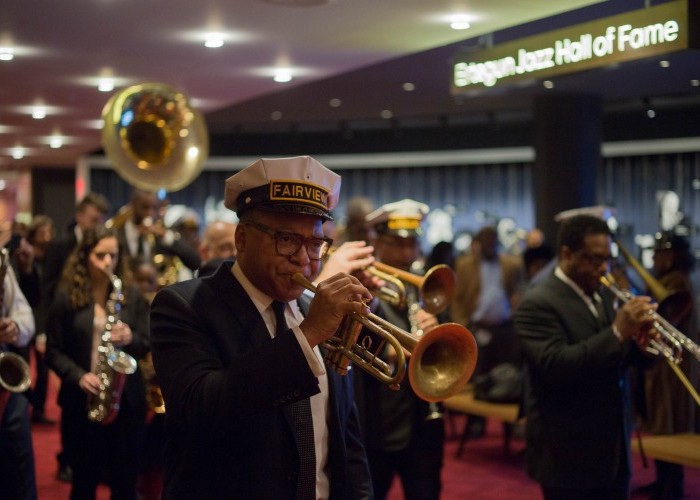Dec 9, 2025 12:28 PM
In Memoriam: Gordon Goodwin, 1954–2025
Gordon Goodwin, an award-winning saxophonist, pianist, bandleader, composer and arranger, died Dec. 8 in Los Angeles.…

Led by Wynton Marsalis and his Jazz at Lincoln Center Orchestra, the memorial concert for Roy Hargrove at Lincoln Center began with a traditional, New Orleans-style second line march.
(Photo: Lawrence Sumulong)Around 11:30 p.m. Tuesday at Jazz at Lincoln Center, as the memorial concert for Roy Hargrove neared its fifth hour, there was an air of fatigue among audience members. Some had started to leave the Rose Theater.
But George Wein and Roy Haynes, in a cowboy hat, still were seated near the front of the stage as the RH Factor, the final act, began playing its intense, gnashing form of hip-hop-inflected funk, with cameos from Common and Terence Blanchard. After the set concluded, the reinvigorated concertgoers made their way over to Dizzy’s Club Coca-Cola, in the same building, for an after-party.
Hargrove, the irreplaceable trumpeter and occasional singer who died Nov. 2 at age 49 from cardiac arrest caused by kidney dialysis, was a fixture at late-night jam sessions, and one gets the sense that he would have appreciated the soulful effort last night on his behalf.
When Hargrove died last year, he hadn’t released an album in about a decade—his last was 2009’s Emergence, featuring his big band. But he still was a ubiquitous presence on the scene, a standard bearer, mentor and inspiration to jazz musicians around the world, and regarded as an artist who had managed to make jazz cool and stylish, without compromising its integrity.
“He demystified the music with his direct, emotional playing,” bassist Christian McBride, who hosted the event, said in his opening remarks, “and in doing so, mystified us with his direct, emotional playing.” Later, McBride deadpanned, “He certainly was the first brother I saw to wear Air Jordans with an Armani suit.”
Appropriately, the show included about 200 musicians and had a motley quality befitting Hargrove’s inclusive musical approach, a big tent covering post-bop, neo-soul, funk, hip-hop, Latin jazz and other styles.
It all began with a traditional, New Orleans-style second line march through the aisles, led by Wynton Marsalis and his Jazz at Lincoln Center Orchestra. Hargrove’s big band put forth lush orchestrations and soulful voicings, and the Dizzy Gillespie All-Star Big Band, of which Hargrove formerly was a member, featured a surprise appearance by Jon Faddis, whose bright, upper-register soloing was a highlight.
Several former members of Hargrove’s celebrated quintet took the stage, including drummer Karriem Riggins, alto saxophonist Sherman Irby, bassist Gerald Cannon and pianist Marc Carey. A number of elders made appearances, as well, a testament to Hargrove’s generation-spanning influence: George Cables, Ray Drummond, Gary Bartz and Jimmy Cobb all jammed on “The Song Is You.”
Dee Dee Bridgewater joined the group for Horace Silver’s “Peace,” which she performed with Hargrove decades ago in Paris. On Tuesday, she also took part in an electrifying scat-off with Italian vocalist Roberta Gambarini, who also sang Benny Golson’s “I Remember Clifford,” substituting “Clifford”—another trumpeter who died too young—for “Hargrove.”
Norah Jones, an alumnus of Booker T. Washington High School for the Performing and Visual Arts in Dallas, where Hargrove was a student, also made an appearance. “He was the pride of our school,” Jones said, before singing a lovely, country-fied version of “The Nearness Of You,” a 1938 tune by Hoagy Carmichael and Ned Washington. But Jones learned the tune, she said, by listening to Roy Hargrove.
The concert, which was free and open to the public—seating was first-come, first-served—had a loose, convivial atmosphere, with the lights kept on, intentionally or not. Hargrove’s family was seated at the front. At different points throughout the evening, an older couple made its way into the aisle to dance, much to the audience’s delight. The hall was packed to capacity, and for those who couldn’t find a seat, the concert was streamed in the atrium outside and also online.
Aida Brandes, Hargrove’s wife, sang a single tune, and vocalist Renée Neufville performed a song whose lyrics she had written earlier in the day. Lezlie Harrison, accompanied by a soulful organ trio, took on “I Wish I Knew.” And at one point, Jon Batiste, The Late Show with Stephen Colbert bandleader, sat in at the piano. A list of performers here almost would be endless.
The show was billed as a celebration of sorts, and there were countless moments of flashy brilliance and understated beauty. But at its core, the evening was a glaring reminder of Hargrove’s absence. DB

Goodwin was one of the most acclaimed, successful and influential jazz musicians of his generation.
Dec 9, 2025 12:28 PM
Gordon Goodwin, an award-winning saxophonist, pianist, bandleader, composer and arranger, died Dec. 8 in Los Angeles.…

Belá Fleck during an interview with Fredrika Whitfield on CNN.
Jan 13, 2026 2:09 PM
The fallout from the renaming of the John F. Kennedy Center for the Performing Arts to include President Donald…

Flea has returned to his first instrument — the trumpet — and assembled a dream band of jazz musicians to record a new album.
Dec 2, 2025 2:01 AM
After a nearly five-decade career as one of his generation’s defining rock bassists, Flea has returned to his first…

Dec 11, 2025 11:00 AM
DownBeat presents a complete list of the 4-, 4½- and 5-star albums from 2025 in one convenient package. It’s a great…

“It’s a pleasure and an honor to interpret the music of Oscar Peterson in his native city,” said Jim Doxas in regard to celebrating the Canadian legend. “He traveled the world, but never forgot Montreal.”
Nov 18, 2025 12:16 PM
In the pantheon of jazz luminaries, few shine as brightly, or swing as hard, as Oscar Peterson. A century ago, a…